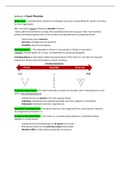Lecture 1 Team Theories
Work teams = interdependent collection of individuals who share responsibility for specific outcomes
for their organization
Why are teams popular? (Hackman) Benefits of teams:
“teams offer the potential for synergy, that wonderful state when a group “clicks” and members
achieve something together that no one of them could possibly have accomplished alone”
- Teams bring more resources
- Diversity in background and expertise
- Flexibility, keep the work going
Interdependence = “The dependence of two or more people or things on each other.”
Example: If I grow apples for a living, I am depended on people buying apples.
Interdependence in work teams: Determined by features of the team (i.e., the task and required
output) that define interconnectedness of team members.
Pooled interdependence: The team technically is a team but members don’t really depend on each
other. (Low interdependence)
- Individual tasks are pooled at the end as group output.
- Individual contributions are valued (rewarded) more than collective contributions.
- Redundant individual resources / expertise etc.
Sequential interdependence: First person works on the assignment first, second person improves
the assignment and hands it in.
Reciprocal interdependence: Team works on a complex project/product. Constantly working
together to create output.
- Individuals work simultaneously on all aspects of the task.
- Rewards are based on the collective output/end product.
- Members differ in their type and quantity of resources.
,Task interdependence = The degree to which members (a) depend on another for access to critical
resources and (b) create workflows that require coordinated action.
Example: Medical team:
Corona IC → Low task interdependence
Complex treatment → high task interdependence
Outcome interdependence = The degree to which goals are formulated and outcomes are rewarded
in terms of collective rather than individual contributions.
Example:
Red bull racing team is a team, however both drivers are competing with each other. And when one
of them wins, he gets the trophy as an individual, not as a team.
When a soccer team wins they get one trophy as a team.
What do work teams need to be effective?
➢ Task
- Do not use a team for work that is better done by individuals.
- Some projects turn out better when performed by one talented individual on behalf of a
group than by the group as a whole working in lockstep.
Example: Writing a book (is better done alone). An orchestra requires a lot of coordination and is
very complex, but as a team it can achieve perfect synergy.
➢ Structure
- To reap the benefits of teamwork, one must actually build the team.
- Set boundaries, define relationships, divide tasks, form relationships with stakeholders, etc.
Example: An orchestra is very structured, all the instruments are positioned at a specific place.
➢ Leadership and support
- Leaders need to give direction to avoid ambiguity.
- The organizational context needs to provides support that is specifically tuned to the needs
of work teams.
- It is important to reward collective outcomes.
Example: the conductor in an orchestra is very important, it makes sure the orchestra sounds good.
IMOI model (Ilgen et al., 2005) Allows for feedback loops!
Input:
➢ Team design
- Composition (e.g., KSAs; size, stability; week 3)
- Interdependence (task, outcome; Courtright et al., 2015)
- Leadership and authority (see Hackman, 2002)
➢ Task factors (e.g., complexity; requirements; task type)
➢ Context (e.g., organizational culture, resources; also Hackman, 2002)
, Potential performance (Steiner, 1972): performance that a team could achieve
▪ Is high when teams have the resources (composition, context) that are required by
the task.
Task types and potential performance (Steiner, 1972)
Pooled interdependence
Actual performance (Steiner, 1972)
Actual performance = potential performance – process loss (mediator)
Process loss = Coordination loss & Motivation loss
Mediator: (Marks et al., 2001)
➢ Team processes: “members' interdependent acts that convert inputs to outcomes through
cognitive, verbal, and behavioral activities directed toward organizing taskwork to achieve
collective goals”
- Example: Information sharing and elaboration, conflict management, decision making and
problem solving, physical activities, relational activities, ….
➢ Emergent states: “constructs that characterize properties (not behavior) of the team that
are typically dynamic in nature and vary as a function of team context, inputs, processes, and
outcomes”
- Example: (shared) emotion and cognition, cohesion, climate, transactive memory, shared
mental models, …
Cohesion (emergent state) = The force that binds members to the team and induces them to stay in
with the team.
- Task cohesion: shared commitment to the team task (I find the task important/interesting).
Correlation with performance: .27 (not very strong)
- Interpersonal cohesion: attraction to the team (I like the people in the team).
Correlation with performance: .14 (less strong then task cohesion) → we can hang out and do
something else instead.
Causality between cohesion and performance:





